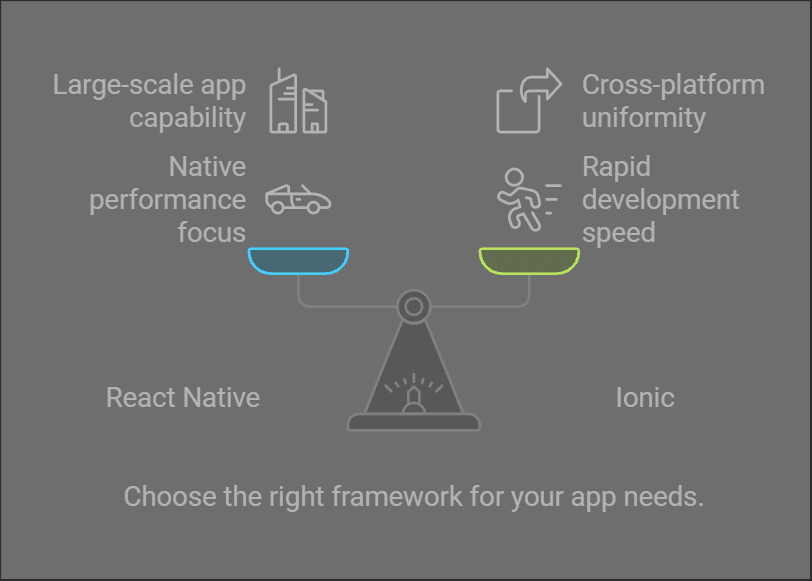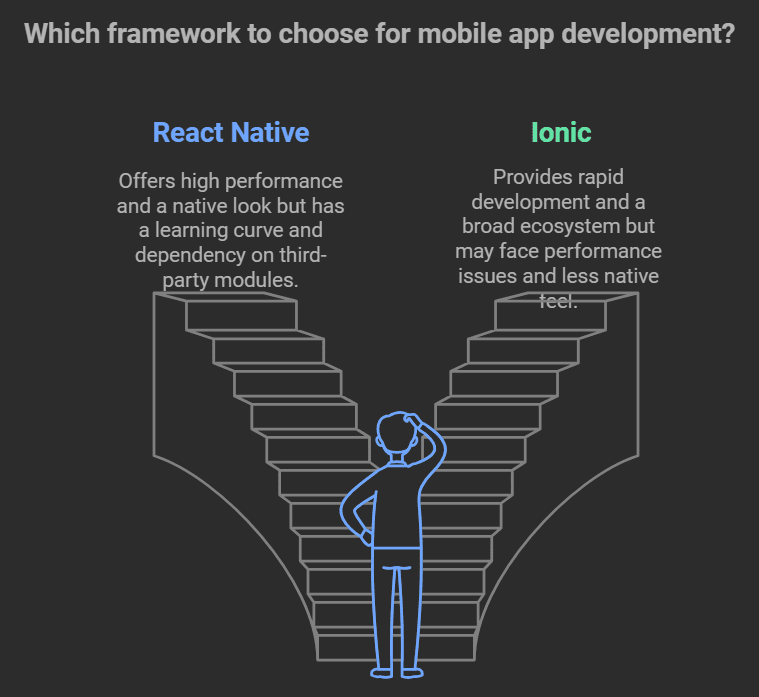React Native vs Ionic: Best Mobile App Framework in 2025

Introduction
Overview: React Native and Ionic are two leading frameworks for mobile app development in 2024. Both frameworks enable developers to build cross-platform applications efficiently.
Purpose: The purpose of this comparison is to help developers, entrepreneurs, and decision-makers choose the best framework for their projects based on performance, ease of use, and other critical factors.
Scope: This comparison will cover key aspects such as performance, development experience, community support, and real-world application scenarios to provide a comprehensive understanding of both frameworks.
Background Information
Historical Context:
React Native, developed by Facebook, was released in 2015, offering a robust framework for building mobile apps using JavaScript and React. Ionic, created by Drifty Co., was introduced in 2013, initially leveraging AngularJS to create hybrid mobile apps with a single codebase.
Current Trends:
As of 2024, React Native continues to gain popularity for its strong performance and ability to leverage native components, making it a favorite for high-performance apps.
Ionic has evolved to support multiple frameworks like Angular, React, and Vue, providing flexibility and ease of use for a wider range of developers.
Relevant Statistics:
According to recent surveys, React Native is used by over 42% of developers for mobile app development, while Ionic is preferred by 16%. Additionally, both frameworks have large and active communities, with React Native boasting over 100,000 stars on GitHub and Ionic having over 45,000.
Core Concepts
Definitions:
React Native is a framework developed by Facebook that allows developers to build mobile applications using JavaScript and React, leveraging native components for better performance.
Ionic, developed by Drifty Co., is an open-source framework that enables the creation of cross-platform mobile applications using web technologies such as HTML, CSS, and JavaScript.
Fundamental Principles:
React Native is based on the principle of "Learn Once, Write Anywhere," meaning that developers can use the same codebase across different platforms while maintaining native performance.
Ionic follows the principle of "Write Once, Run Anywhere," focusing on delivering a consistent user experience across platforms by using web technologies.
Key Theories:
React Native employs a bridge between JavaScript and native code, enabling the use of native components and APIs for a smoother user experience and higher performance.
Ionic, on the other hand, uses WebView to render the app within a browser-like environment, which allows for greater flexibility in using web development skills but can sometimes result in lower performance compared to fully native solutions.
Applications

Practical Use Cases:
React Native is highly suitable for developing high-performance mobile applications where native look and feel are crucial, such as social media apps, e-commerce platforms, and complex utility apps.
Ionic shines in cases where a fast development cycle and cross-platform uniformity are essential, making it ideal for enterprise apps, progressive web apps (PWAs), and apps requiring frequent updates.
Examples in Industry:
React Native powers well-known apps like Facebook, Instagram, and Airbnb, showcasing its capability to handle large-scale, user-intensive applications.
Ionic, on the other hand, is used by companies like MarketWatch and Pacifica, demonstrating its effectiveness in creating versatile and quickly deployable apps across various industries.
Benefits and Drawbacks

Performance
React Native:
High performance with near-native speed and smooth animations. Can be less efficient for very complex applications due to the JavaScript bridge overhead.
Ionic:
Good performance for most apps using WebView for rendering, but might face performance issues in highly demanding applications compared to fully native solutions.
Development Speed
React Native:
Fast development due to reusable code and strong community support. However, there is a learning curve for developers unfamiliar with React.
Ionic:
Rapid development using web technologies with highly reusable code across platforms. More effort may be required to ensure native-like performance.
User Experience
React Native:
Native components provide a natural look and feel. Slight delays can occur in updates as native modules need to be developed.
Ionic:
Consistent user experience across platforms, but the UI may not always feel as native compared to React Native.
Ecosystem
React Native:
Strong support from the React ecosystem with extensive library availability. Sometimes dependent on third-party modules for native functionality.
Ionic:
Broad ecosystem with support for Angular, React, and Vue. Dependency on WebView can limit access to some native features.
Community Support
React Native:
Large and active community with extensive documentation. Over-reliance on community contributions can sometimes lead to fragmented support.
Ionic:
Strong community with good documentation and a variety of plugins, but the smaller community compared to React Native can impact the availability of immediate help.
Best Practices
Code Quality:
Ensure clean, readable, and maintainable code. Use linters like ESLint for React Native and TSLint for Ionic. Follow coding standards and modularize code for better maintainability.
Testing:
Regularly test your app to catch bugs early. Use Jest and Detox for React Native, and Jasmine or Protractor for Ionic. Implement unit, integration, and end-to-end tests to ensure app stability.
Performance Optimization:
Optimize performance by using tools like Hermes for React Native to enhance performance and reduce memory usage. For Ionic, lazy load components and reduce initial load time to improve WebView performance.
Version Control:
Use Git for efficient code management. Commit changes regularly, use meaningful commit messages, and follow branching strategies like GitFlow for streamlined collaboration.
Documentation:
Maintain comprehensive documentation for your codebase. Include comments within the code and external documentation for setup, usage, and API references to facilitate easier onboarding for new developers.
Community Engagement:
Engage with the community for both frameworks. Participate in forums, contribute to open-source projects, and stay updated with the latest best practices and updates.
Security Practices:
Implement security best practices such as input validation, secure storage of sensitive data, and regular security audits. Use libraries and tools specific to each framework to enhance security.
User Experience:
Focus on creating a seamless user experience. For React Native, leverage native components for a natural look and feel. For Ionic, ensure the UI is responsive and consistent across platforms.
Scalability:
Design your app with scalability in mind. Use scalable architecture patterns and ensure your codebase can handle increased load and complexity as your app grows.
Continuous Integration/Continuous Deployment (CI/CD) :
Implement CI/CD pipelines to automate testing, build, and deployment processes. Use tools like Jenkins, CircleCI, or GitHub Actions to streamline development workflows.
Challenges and Solutions
Common Issues:
Performance Bottlenecks:
React Native apps can experience performance issues due to the JavaScript bridge, while Ionic apps may struggle with performance due to the reliance on WebView.
Compatibility Issues:
Both frameworks may face compatibility issues with certain native modules or plugins.
Learning Curve:
Developers new to React Native or Ionic may face a steep learning curve, especially if they are not familiar with JavaScript frameworks.
Debugging Difficulties:
Debugging can be challenging, particularly for performance-related issues or when integrating third-party libraries.
Platform-Specific Behaviors:
Ensuring consistent behavior across iOS and Android can be tricky, as each platform has its own quirks and requirements.
Proposed Solutions:
Performance Optimization:
Use performance monitoring tools and best practices to identify and fix bottlenecks. For React Native, tools like Hermes can improve performance. For Ionic, optimizing the use of WebView and lazy loading can help.
Compatibility Solutions:
Regularly update dependencies and use community-tested plugins to mitigate compatibility issues. Engage with the community for support and solutions.
Learning Resources:
Provide ample training resources, tutorials, and documentation to help new developers get up to speed. Utilize online courses and community forums for additional support.
Effective Debugging Tools:
Leverage debugging tools like React Native Debugger and Ionic DevTools to simplify the debugging process. Implement thorough testing procedures to catch issues early.
Frequently Asked Questions (FAQs)
Q: What are the main differences between React Native and Ionic?
React Native:
Built by Facebook, React Native uses JavaScript and React to develop mobile applications.
It provides near-native performance by compiling to native code.
It offers a rich set of pre-built components and access to native APIs through third-party libraries.
Ionic:
Built by Ionic, it uses web technologies like HTML, CSS, and JavaScript to develop mobile applications.
It wraps these web apps in a native shell, making them function as native apps.
It heavily relies on web views, which can impact performance compared to fully native solutions.
Q: Which framework offers better performance, React Native or Ionic?
React Native:
Generally offers better performance because it compiles to native code.
Provides a more native-like experience, with smoother animations and faster load times.
Ionic:
Performance can be slightly lower compared to React Native, due to its use of web views.
Suitable for apps that don't require intensive graphics or performance-heavy operations.
Performance can be optimized with the right practices and tools.
Q: Can React Native and Ionic be used for both iOS and Android apps with a single codebase?
React Native:
Yes, React Native allows developers to build applications for both iOS and Android using a single codebase.
Code sharing and reuse are maximized, reducing development time and effort.
Ionic:
Yes, Ionic also enables the development of iOS and Android apps from a single codebase.
Utilizes web technologies, making it easier for web developers to transition to mobile app development.
Offers a consistent look and feel across platforms, though some native-specific adjustments may be needed.
Conclusion
In conclusion, choosing between React Native and Ionic in 2024 depends on your project's needs.
React Native excels in performance and offers a native-like experience, making it ideal for apps needing high efficiency and smooth animations.
It's great for developers familiar with React. Ionic, on the other hand, uses web technologies, allowing for a quicker development cycle and easier integration for web developers.
It's perfect for rapid prototyping and less performance-intensive applications.
Ultimately, the best choice depends on your app's requirements, the development team's skill set, and the desired user experience. Both frameworks continue to evolve, promising exciting advancements in mobile app development.
